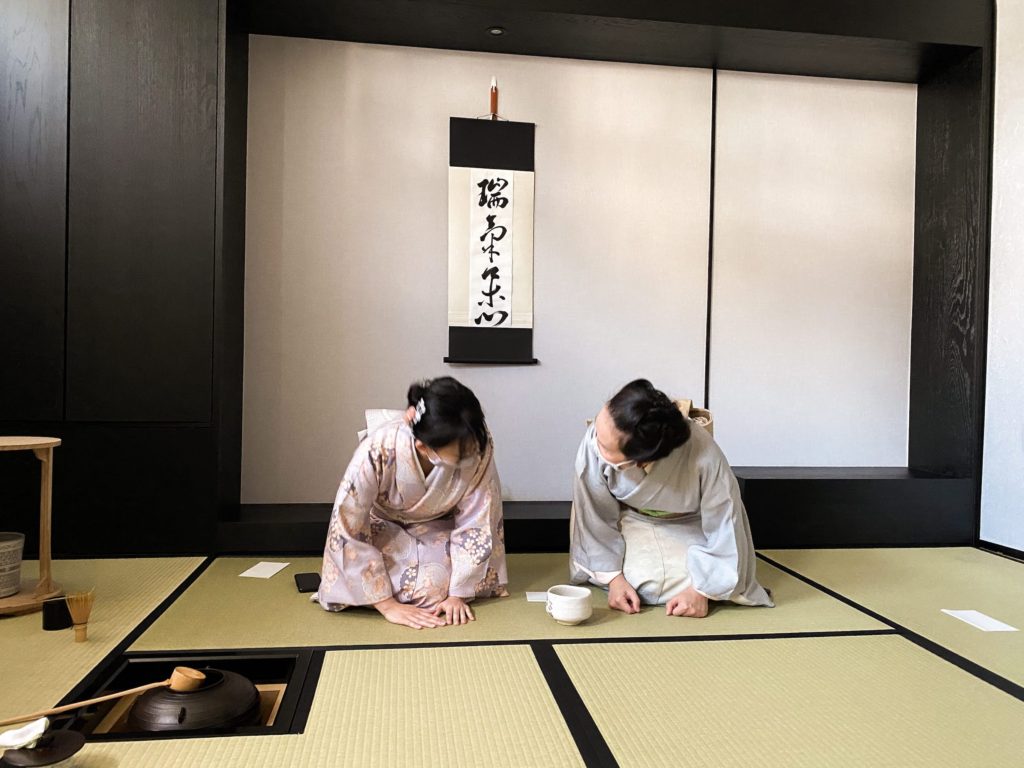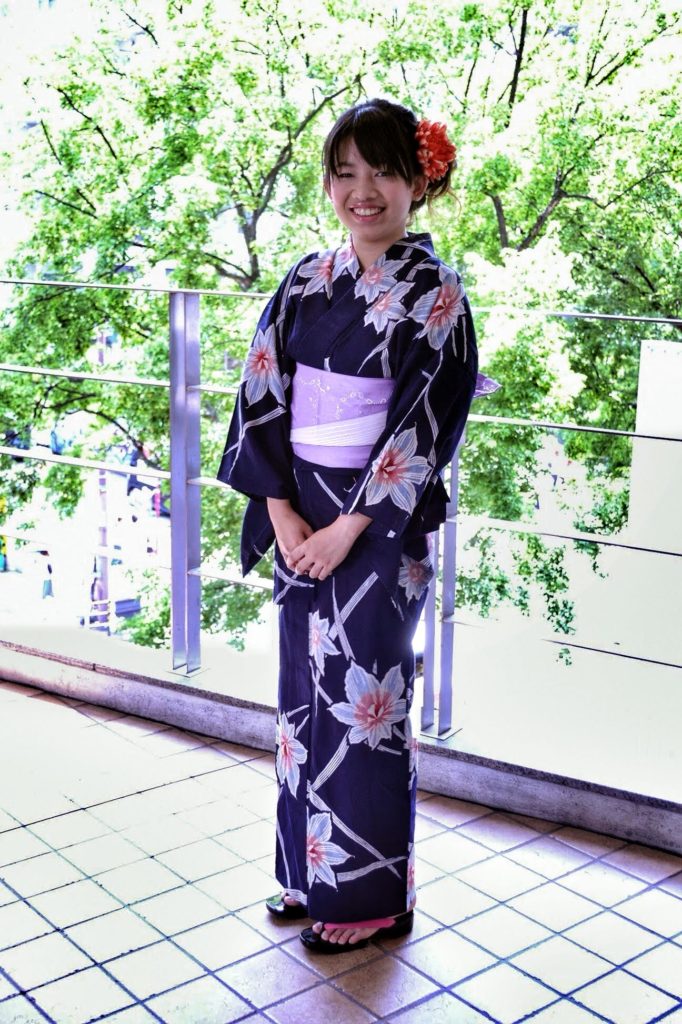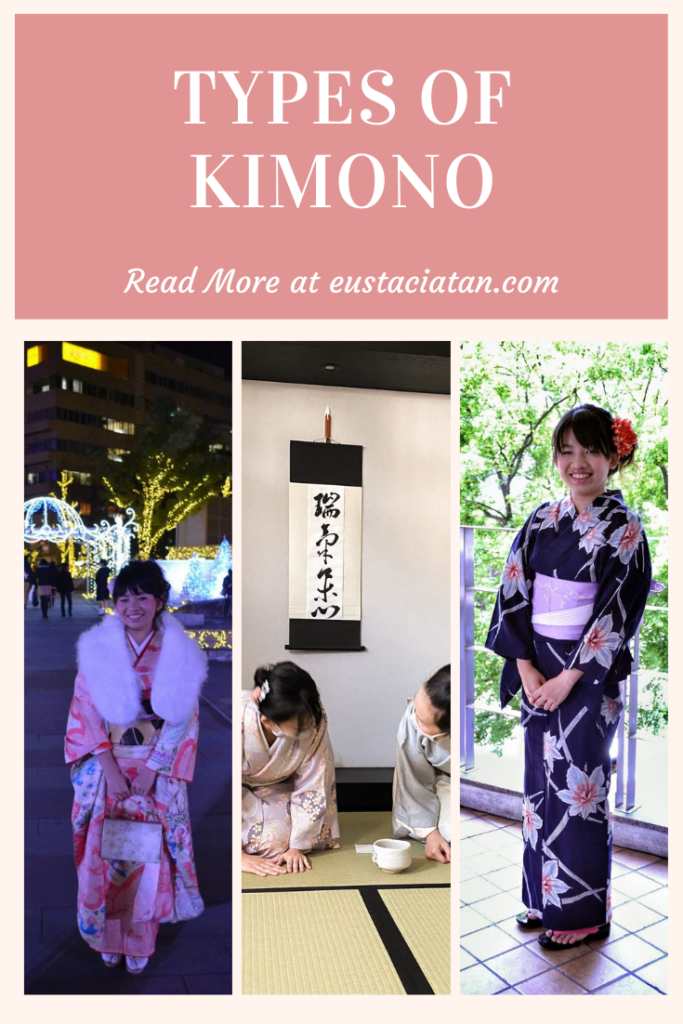I bought a new Japanese book! Way back when I was living in Japan, I went for lessons with Morita-sensei. As part of my lessons, I bought a book on how to put on kimono correctly but I didn’t have anything more general about kimono. So I figured it was time to get another one of Morita-sensei’s books, namely 森田空美のはじめてきものきほん事典 (Morita Akemi’s Introduction to Kimono Encyclopedia), so that I could learn more.
Today, I want to share about the different types of kimono available and show you that it’s not just furisode and yukata.
Formal Kimono
The two most formal kimono available:

黒留袖 (Kurotomesode): This is the most formal kimono available for married women and if you’re at a wedding, the mothers of the bride and groom will most likely be wearing this. The base of this kimono is black and the patterns are only found on the 裾 (suso – the skirt of the kimono). Another feature of this kimono are the presence of emblems (紋; mon) on the back of the kimono, the back of both sleeves, and the two sides of the bust area (this is called 五つ紋; itsutsumon [1])
See also – 色留袖 (irotomesode), another type of 留袖 (tomesode) [2]
振袖 (Furisode): The most formal kimono for unmarried women. This is most commonly seen during the coming of age ceremony and at formal parties. The furisode can be recognised by its distinctively long sleeves and the term “furisode” comes from the beginning of Edo-period Japan.
Other formal kimonos

色留袖 (Irotomesode): This is similar to the 黒留袖 (Kurotomesode), but the base colour of the kimono is not black. In recent years, this is considered a very formal kimono for unmarried women and if the five emblems are on the kimono, it is basically as formal as a 黒留袖 (Kurotomesode). If there are no emblems on the kimono, then it is about as formal as a 訪問着 (Houmongi).
訪問着 (Houmongi): This kimono is suitable for a variety of events, from weddings to formal parties and can be worn by both married and unmarried women. In terms of formality, this is second only to the 留袖 (tomesode). The range of motifs for the houmongi is varied, from traditional patterns to more modern ones. If the patterns are are dense (密度が濃い), the kimono is considered slightly more formal than one with more restrained patterns.
付け下げ (Tsukesage): The patterns here are a little simpler compared to the houmongi and this kimono came about after WWII, when the more gorgeous houmongi were banned. Here, the patterns on the skirting may not connect with the patterns on the sleeves. The formality of this kimono can be adjusted by changing the type of obi paired with it.
色無地 (Iromuji): A simple, one-colour kimono has always had a place in important ceremonies, such as a bride’s white kimono (Shiromuku; 白無垢) or a black mourning kimono. An Iromuji kimono consists of a piece of cloth dyed in one colour, without any type of patterns. This kimono is also appropriate for mothers to wear for entrance and graduation ceremonies, and is suitable if you’re invited to attend a tea ceremony. The most important part of this kimono is whether there is a family crest – three or five crests might be a bit much (this is a literal translation from the book) but an Iromuji with one crest is suitable for a lot of places.
喪服 (Mofuku): You could consider this a subset of Iromuji kimonos because a Mofuku is a kimono dyed in one dark colour (such as black or dark grey) and is used for mourning. These kimonos normally come with five crests.
Formal & Casual Kimono (Suitable for both occasions)

小紋 (Komon): Komon’s are possibly one of the most versatile kimonos out there, since they can be dressed up for semi-formal occasions (or even up to weddings at restaurants/wedding after parties) or just dressed fairly casually for a day out. Komon means “small pattern” and it refers to kimonos with repeating patterns that are found around the whole garment.
江戸小紋 (Edo Komon): A subset of the Komon, the distinguishing feature of Edo-komon is that if you look at it from a distance, you wouldn’t be able to tell that it’s got a pattern all over the cloth. As an example of how important the kimono is, If you pair a one-crest Edo Komon with a fukuro-obi, the ensemble becomes a bit more formal, whereas a one-crest Edo Komon with a Nagoya obi is an outfit suitable for going to town.
Casual Kimono [3]

紬 (Tsumugi): The representative type of woven (織り) kimono, the Tsumugi is made throughout Japan. Materials used for weaving include natural and lab-made fibres. Recently, Tsumugi kimonos dyed in one colour have been popular because they are easy to coordinate. And while Tsumugi are considered casual kimono, if you use the right obi and accessories, you could possibly use it for a for slightly formal occasions (like dinners).
普段浴衣 (Fudan Yukata): Yukata has roots in the Heian-era (medieval Japan), as the cloths that the nobility would wear when taking a bath [4]. During the Edo-period, these cotton kimonos because very popular among the commoners as after-bath clothes. Because of this, Kimonos are considered casual summer clothes. If it helps, you can think of them as the equivalent of T-Shirts and Jeans.
よそゆき浴衣 (Yosoyuki Yukata): While yukata are generally seen as casual clothes [5], It is possible to dress them up a bit. If the Yukata pattern isn’t too bright, you could wear a summer nagajuban (instead of not having a nagajuban), tabi (instead of going barefoot in geta) and turn it into a summer kimono. In this case, you should be pairing it with obis like the Nagoya Obi in a Hakata-weave.
Concluding Remarks
I hope this helps to bring some clarity to the rich world of kimono! When I first started learning how to wear a kimono, I thought there was only one type but clearly, the kimono is a complex and nuanced garment. I’ll be writing a second post on kimono tailoring and obi, so if you have any questions about the kimono or if there are any aspects that you want to learn more about, please let me know and I’ll try to address them!
If you’d like to have all this info in a PDF sheet (organised by event), I’ve put together an infographic on what type of kimono to wear to various events – available at my ko-fi!

Footnotes
[1] These emblems are family emblems (a tradition dating back to the Heian period) and are a must for the most formal types of kimono. These are created by not dying the cloth in specific areas. There is a type of ‘fun’ emblem called 洒落紋 (sharemon), which is sewn on rather than not-dyed, but this is for less formal kimono like 色無地 (Iromuji) and 小紋 (Komon).
[2] 留袖 (Tomesode) comes from the Edo period, where women would modify their furisode when they got married or turned 18 by shortening the sleeves. This modified kimono came to be called tomesode, and since the furisode is considered formal wear, the tomesode is also considered formal wear.
[3] Technically, based on the material used, there are a few more categories of informal kimono. Under the casual kimono section, the types of kimono are: Edo-komon, Komon (these two are covered in the post), Omeshi, Tsumugi, Momen,Orinokimono, Fudan Yukata, and Yosoyuki Yukata.
[4] These clothes were called 湯帷子 (Yukatabira).
[5] Which means that you cannot wear them into hotels and formal restaurants.

Great photos! I always learn something when I tead your posts!
Thank you! Glad it was informative!
I am so amazed by how little I knew about the kimono until I read your post! Thank you for this simple guide!!!
I’m glad you found it helpful! It was a steep learning curve for me hahaha I didn’t know it was so complex too!
My goodness, I had no idea there were so many kinds of kimono! And, I never thought I’d see the phrase “casual kimono” ever! Thank you for educating, and for modeling for us.
Question: are they hot to wear? It seems as if they would be, with so many layers.
Kimono can be pretty warm, but there are also summer versions. The two biggest changes would be: the nagajuban layer beneath changes to cotton (from a thicker silk) and the kimono itself becomes a single layer and is made of a lighter material. This helps make a big difference in how hot the kimono is!
Wow! I had no idea there were so many options to choose from! Is the casual kimono more comfortable to wear, or is the idea of casualness just from how the garment looks? Also, how does one get a family crest?
The casual kimono (e.g. Komon or Yosoyuki Yukata) just looks more casual (in terms of patterns, lack of fancier gold and silver thread, etc). The Yukata is a single layer (no inner layer called Nagajuban) but honestly, it feels very similar to other casual kimonos to me!
For me, the presence of elastic bands (sometimes used to help put on the kimono) make a bigger difference to the comfort level!
The crests (or kamon/家紋 in Japanese) indicate clan allegiance, so if you’re Japanese, you can look up where your family is from and see what your crest should be. I’ve never tried buying this as a foreigner, so I’ve no idea if I can even use one of these! My formal kimono is a regular houmongi without any crests.
This was so lovely!!
Thank you!!